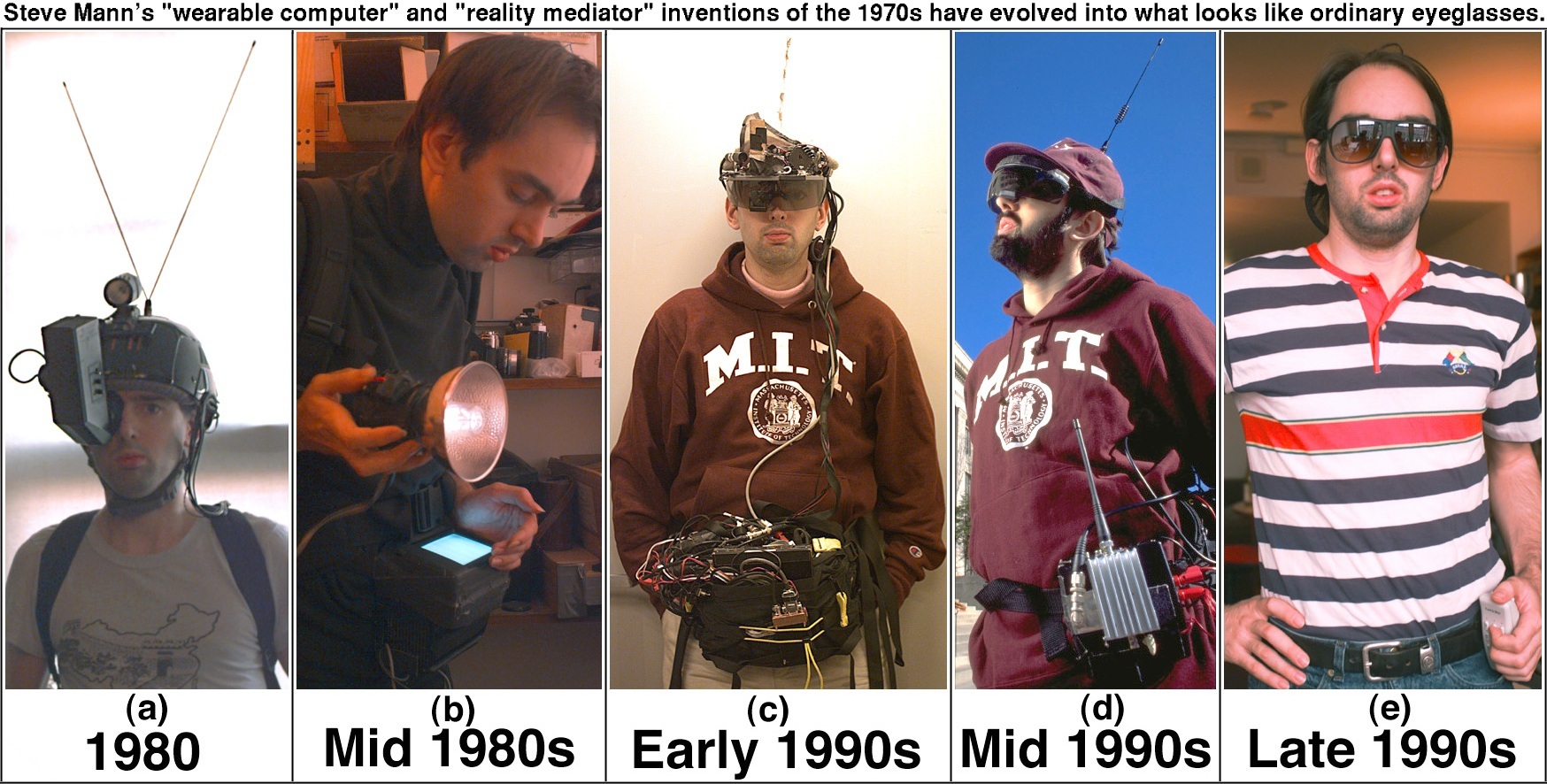
Three revolutions in speed divide three centuries, from the nineteenth to the twenty-first. The first, from the nineteenth century well into the twentieth century, is the revolution in transportation. Its heroes could be Jules Verne and Howard Hughes, each in his own way. The second is the revolution in transmission, whose hero could be Steve Mann or Jaron Lanier. And the revolution in transplants, of course, is the third: that's Professor Warwick...(who)had a microchip sewn into himself to avoid wearing a badge while walking around this laboratory and this university... So you see, we have three characters and three revolutions.Paul Virilio, Crepuscular Dawn
If Paul Virilio can highlight Steve Mann as a hero of the "revolution
in transmission," it's because Mann's experimental deployment of
technology has already migrated his thought beyond the limits of the
earth-bound human species, becoming the engineer/artist who
has relentlessly explored the spectral dimensions of the post-cyborg
body. Famous both for his invention of the wearable computer while a
graduate student at MIT and for his translation of the myth of the
cyborg into practical how-to-do-it classes at MIT and the University
of Toronto on actually becoming a cyborg (complete with flesh plug-ins
and Neuromancer vision), Mann is a courageous and brilliant explorer
of the dark side of network culture, namely the transformation of the
utopian dreams of cyberspace into the hyper-1984 reality of the Total
Surveillance Society. Perhaps not content with his role as a hero in
the "revolution of transmission," Mann's artistic work focuses
critically on the "revolution in transplants." Specifically, at an
annual Toronto performance art event called Deconism, Mann brings
together artists, theoreticians and leading thinkers of our times to
decontextualize, deconstruct, decontaminate and deconfigure the
tendencies to domination inherent in the age of bio-politics. Of
course, in a wired culture where futurist theory almost immediately
flips into grisly political reality, Deconism 2002 which focused on
the politics of mass decontamination was an eerie prelude to
the recent announcement by the Bush Administration that, under the
pretext of the never-ending war on terrorism, each American family
should prepare for terrorist strikes against the homeland of the iconic suburban house, with plastic sheeting and duct tape for windows in addition to a three day
supply of food and water. In Virilio's scenario of war where the state
first and foremost declares war on its own population, Mann's vision
of mass decontamination procedures as the inevitable prelude to the
society of total domination is deeply prophetic.
Arthur and Marilouise Kroker
Editors, CTheory

The Post-Cyborg
Loosely speaking, the cyborg-age of yesterday is connected with ideas of postmodernism, deconstructionism, and posthumanism (itself, somewhat related to the ideas of cyborgism). But these ideas, along with culture jamming, as well as my own sur/sousveillance situationist street theatre, have become ineffective in the contemporary age of Terror.
| Although the rise of dot commerce, and with it, the growth of spam, certainly destroyed the distinction between culture jamming and culture spamming, Terrorism, and perhaps, more significantly, the response to terrorism, have given birth to a new impotency of inverse culture. | All Ads are Culture Jamming |
Whether terrorism is the work of a lone miscreant, a foreign government, or an "inside-job" by one's own government (or some mixture of these, such as a "blowback" response from injustices we inflict on others), it is the aftermath of war's equation or inequality that often has the widest felt impact. Virilio refers to "images" as giving us a new era of war. In this sense, TeleVision is a weapon of mass destruction/distraction/distrust, as we are assaulted by a blitzkrieg of graphic repetition that reaches into the innermost spaces of every home.
| Before the World Trade Center was destroyed, I had begun to wonder, in the postmodern age that we then lived, if we could distinguish between high culture and low culture, between Derrida and Disney, or between Coke's satire of the Pepsi Generation and Adbusters' use and promotion of Adobe Photoshop (TM). At the height of the spam-era, it seemed as if, perhaps, all advertisers were Culture Jammers. As our inboxes filled with digital detritus, we began to lose our ability to distinguish Jam from Spam. Gaptivism had already brought us an era in which advertising was mimetic with activist forces. | Not Jam or Spam but Gaptivism |
But the same filters that eliminate annoyance-based repetition advertising (whether our own human ability to ignore things -- ignorance being necessary to survive the New Deconomy -- or our prosthetic technology-based ignorance-enhancers) have made us equally deaf to Jam.
I recently received some Spam from a group called "Culture Jammers Network", calling for me to visit their web site to donate money to a "Culture Jamming" network to fight consumerism and advertising. But I could not visit their website because, instead of buying all the software that would be necessary to access their website, I assembled an old computer system from items salvaged from dumpsters, and from curbside trash. Then instead of buying software, I had built on top of much of the GNU Linux FreeSource. Because I was not willing to support consumerism and software swatshops, my computer system does not run Macintosh, Microsoft, Macromedia (MacMicMac), Flashism, etc.. Because I was not willing to support the consumerism and advertising, I was not able to properly respond to their Spam.
Consequently, one wonders if there is a distinction between Granolafied Gaptivism and Culture Spamming/Jamming that appeals to us to use corporate-owned software systems to participate in supporting the selling of a colour glossy magazine, or the purchase of advertising space for inverse ads, because all ads are inverse ads. All advertising is aimed at "hacking" our human capacity to ignore ads. Thus all advertising is, to some degree, culture jamming.
Although detournment (a la Situationist Internationale) may re-situate the tools of an oppressive monoculture regime in a disturbing and disorienting fashion, to call into question the values of that regime, the "regime" itself sooner or later re-re-situates those same tools. I call this detournment2 (detournement squared, i.e. detournement of the detournement). For example, some of the great reality-hacking of French artist Magritte has been incorporated into much of our advertising "culture".
Then, of course, we can hack the hackers of the hackers, by re-situating the tools of modern advertising to call into question the monoculture that calls into question the non-monoculture. This I call detournment3 (detournement cubed, i.e. detournement of the detournement of the detournement). See for example, http://wearcam.org/easel.htm.
As this low-intensity peacefare is waged between culture and its counter, the exponent continues to grow, detournmentn (detournement to the nth degree).
As we blur the lines between culture and counterculture, it becomes more difficult to tell whether the exponent is even or odd, or even if it's an integer -- an odd feeling of confusion.
The equation of double detournement
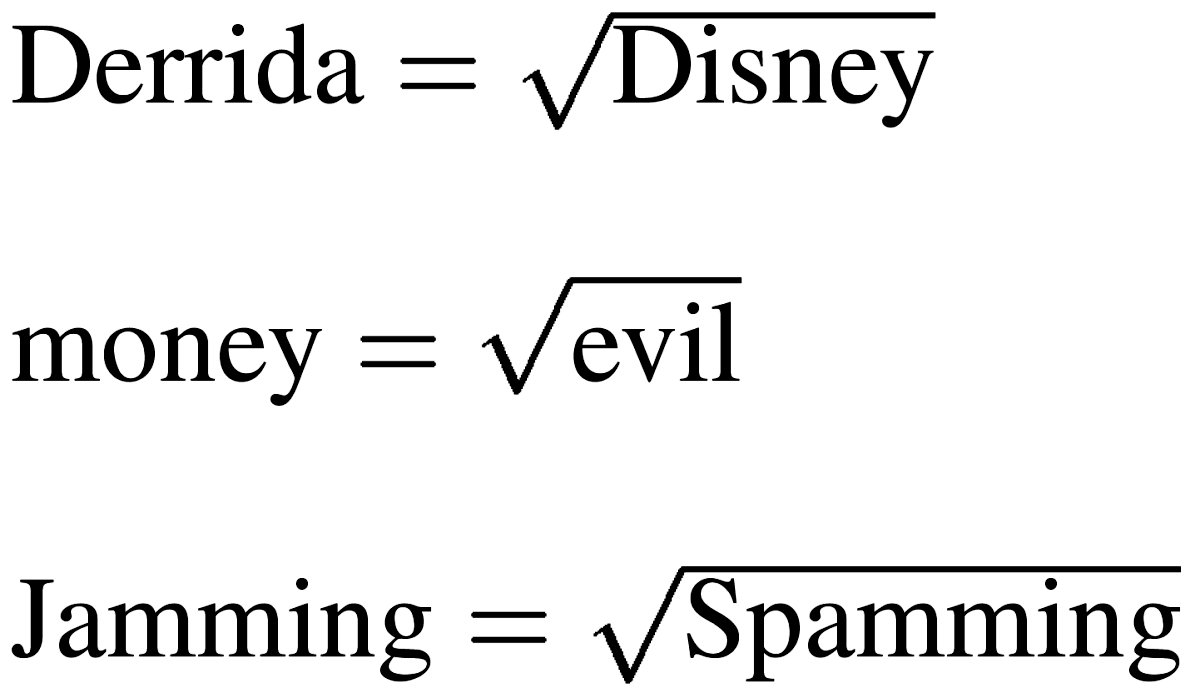
that seemed so clear yesterday, seems confusing in the aftermath of the
terrorist inequalities.
So Magritte's "high culture" has alternately oscillated down to "low culture" and back up, back and forth, cycling in simple harmonic motion, but eventually fading out to the point where we can no longer tell up from down.
Antonin Artaud coined the phrase "Virtual Reality" in the 1930s to describe theatre ("la realité virtuelle" translated in "The Theater and Its Double", 1958).
Thus Virtual Reality was once a form of "high culture" that has now been co-opted by advertising giants.
Ironic, indeed, that the epitome of simulacra is theatre. But now all the world's a stage. And there's no longer a difference between theatre and shadow.
Thus, at least in some sense, satire is no longer possible because the classical Greek Theatre's Proscenium has been smashed to pieces, in the sense that we can no longer distinguish between the audience and the players.
At first glance, one might be inclined to regard DECONference as a Greek Tragedy. The shower (which every attendee was required to take, after being searched and stripped) calls to mind cleansing. DECONtrabanding is for purity. DECONtamination is a catharsis of contamination. Fear and pity for and among the "victims" of the bioterror attack that DECONference initially simulates with the script of an anthrax scare.
But it is also an Inverse Brechtian Theatre, where the audience is distanced from the actors -- emotionally detached -- and separated by the walls of a biohazard containment suit. It is Inverse Theatre (Inverse Epic), because the attendees are really the actors (whether they know it or not), and the DECONtamination facility staff (the decon officers off in some distant darkened room, staring at surveillance monitors) are the audience. There's nothing quite so Inverse Brechtian as being required to strip naked in front of an audience fully dressed in biohazard suits.
The DECONism gallery/museum space was a stage, where the actors went through the ritual cleansing before receiving a white paper jumpsuit and being sent to the "upper room" (actually the roof of the gallery).
The Anthrax Theatre we see on television is more real than reality.
By reversing the roles of audience and actor, we challenge the directionality of the Proscenium, and thus, its very existence. Theatre has consumed itself. Artaud's theatre of "Virtual Reality" is no longer an oxymoron -- it's the everyday world in which we live. And in the same manner in which theatre has consumed itself, postmodernism, to some extent has also consumed itself, and certainly deconstructionism has deconstructed itself. The fact that students in theatre school think that they can change the world with theatre seems so closely aligned with Baudrillard's observation that the hair and fingernails of a corpse continue to grow after it is dead. If freedom's not dead, at least theatre is. It was once said that New York's Times Square was the world's stage. But Baudrillard's Requiem for the Twin Towers should also spell a Requiem for Theatre.
Perhaps, satire is no longer possible because the division between audience and players has been disrupted. Like a free-flowing acid, satire eats through the flesh of the machine.
And what of biological terrorism? We're constantly bombarded with images of people being stripped naked and hosed down in parking lots outside buildings where white powder spilled on a table. Table salt spilled on a table. Or maybe icing sugar.
ARMED VISION
Jordan Crandall's depiction of the military's desire "to both violate and shield ... erotic charge of combat... analyze/violate/protect" is perhaps best captured in defense against bioterror (irrespective of whether the bioterror be real, imagined, or merely an "inside job").
Military computer vision systems are now turned back toward us where the hidden cameras in the public baths transform our world from Baywatch to Bathwatch. Hidden underwater cameras in municipal swimming baths. For example there is a network of underwater cameras at North Toronto Community Center, connected to a sophisticated network of Internet connected computers. From Baywatch (the many watching the few) to Poolwatch (the few watching the many), we become the specimens of an experiment, perpetrated from afar, without our knowledge or consent. Is it a swim meet, or a swim meat? Perhaps by now television cameras have outnumbered television receivers. Even in places where we're not fully clothed.
Lifeguard Rescyou. To surf and protect from afar.
I was recently asked to give a presentation for Toronto artist Doug Back's exhibit "Shadow Grappling". In one of his works, we see the magnified image of a fingernail -- the voyeuristic sustained gaze focused upon what might have been bitten off -- a nail-biting frenzy of fear -- fear from the feeling of not being protected. It hangs at waist-height, as if to suggest being of the belly, being born of terror, or saliva to the abdomen. And we can only see it on TV. TV is the new reality in the age of anthrax angst. Mediated like Jacob Wrestling with a Digital Angel. Television, Terrorvision. Or the campground. Strong Angel. (Shower hours)
Foucault once said "Authority loves the plague". Today he might have said "Government loves anthrax". Or "Covernment loves terrorism". Queue up like cattle to be stripped, scrubbed, shielded, protected, and saved. Rescyou in the resqueue.
Quenching our own fire
Training for submission to the bioterror state Fighting fire with water. Showers of lead and sparks. From muzzle to nozzle.
| In the past we trained for war by waking up in the middle of the night and quickly dressing to fight. Now we train for war by falling comatose to commonsense and getting undressed in the middle of the day to submit. We cannot bear the thought of firepower. We have instead been taught waterpower. We are taught not to fire, but to quench our own fire. But not to quench our own anger, for that would put an end to the war. Our anger is fueled by state sponsored media, so that the state can continue to fund the war on terror, so that we can continue in our training for war. Not so we can learn to fight, but so that we can be trained to submit to authority. | Today we train for war by falling comatose to commonsense |
Showers of lead and sparks have dissolved into soap showers. Or bleach showers. Gunpowder has been replaced with a solution of nine parts water, and one part household bleach. Submission drills are like fire drills. In the past we learned how to get out of buildings. Now we learn how to get out of our clothes. As a nation declares war on its own people, it must ensure its people don't fight back. It must strip its people. Terror control agents Pepper spray, or agent orange? Or chemical agent provocateur. Or provacateurrorists.
Soap down the unruly unwashed masses. Soap is the solution for the great unwashed. Stop terror with suds.
The fundamental lesson we've yet to learn is that lacking any fundamental rooting we may be washed away like topsoil that lacks age-old vegetation, leaving behind only those who are more deeply rooted than ourselves.
Decon is about people, places, things, or shall we say, people, displaced, without their things.
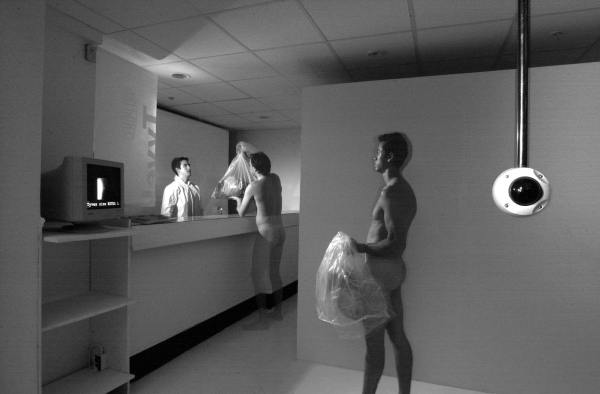
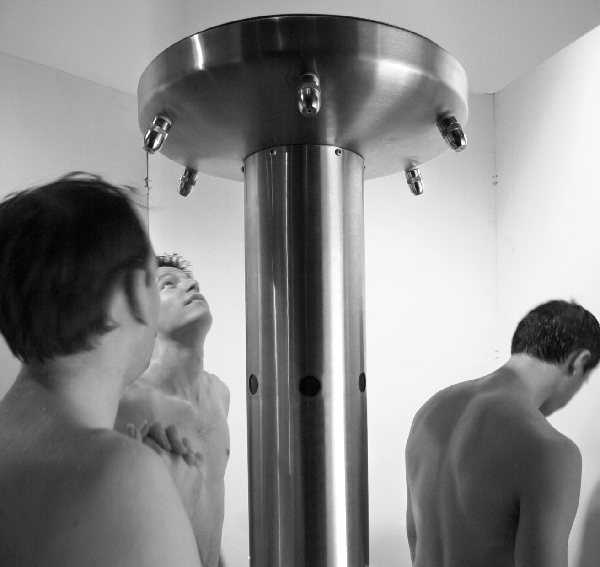
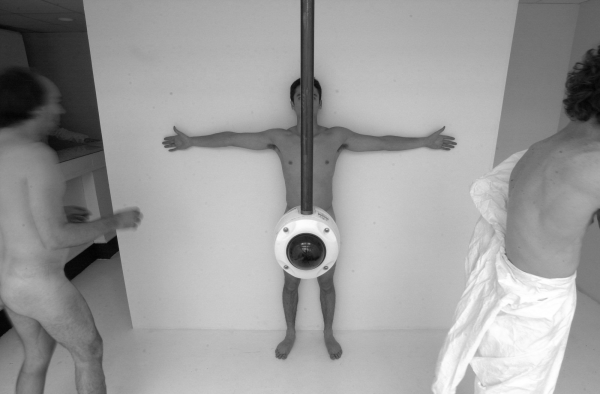
(Three steps: (1) Strip=Violate, (2) Wash=Rape, (3) Cover=Protect)
(1) All attendees are required to remove all clothing, jewelry, and personal
effects and check these items at the baggage counter prior to being allowed
into the museum space.
(2) They are then required to go through decontamination.
(3) Finally they are to line up to get their bodies scanned by a computer, in
order to automate the issuing of uniforms, so they can receive a
paper jumpsuit that has no pockets in which to conceal contraband.
Now the attendees are safely protected
from themselves and each other, so that they can attend
DECONference 2002.
AXES OF EVIL
Most importantly, perhaps DECONference raised questions such as "is there really an inverse"? Is there really an inverse to surveillance? Is there really an inverse to constructionism? Is there really an inverse to evil?
Origin of Evil
"Axes", typically denoted (x,y), meet at a point called the "Origin," typically denoted (0,0).
We have been told that IRAN and IRAQ are the "Axes of evil."
But we have not been told what country is at the "Origin of evil".
But If the enemy is within -- within our own hearts, and within our collective selves, we must equally consider questions like "What if terrorists infiltrated positions of high authority or power?" and "How can we defend our nation against terrorists operating from within the military?".
In the spirit of questioning the direction of the "Axes," DECONference 2002 called into question the distinction between Left and Right, in the sense that it also blurred the line between covernments and gorporations.
Further reference
--------------
Steve Mann is a professor of engineering at the
University of Toronto. He is also an artist who has exhibited work in
galleries and museums throughout the world, including the Museum of
Modern Art (New York), Stedelijk Museum of Art (Amsterdam), San
Francisco Art Institute, to name but a few. Steve Mann is regarded by
many as the inventor of the voice activated wearable computer and
the EyeTap camera.
BACK